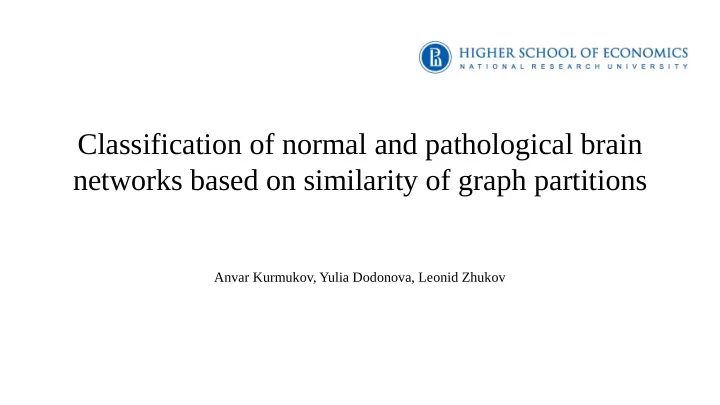

Classification of normal and pathological brain networks based on similarity of graph partitions Anvar Kurmukov, Yulia Dodonova, Leonid Zhukov
Anvar Kurmukov Classification of normal and pathological brain networks based on similarity of graph partitions What is connectome ? (spoiler connectome = brain network) In a macro-scale view connectome is a graph in which nodes correspond to different brain regions ( R egions O f I nterest), while the edges are connections between those areas. 2
Anvar Kurmukov Classification of normal and pathological brain networks based on similarity of graph partitions Tasks to solve 1. ROI definition 2. Time series extraction / Tractography 3. Connectivity matrix 4. Supervised learning
Anvar Kurmukov Classification of normal and pathological brain networks based on similarity of graph partitions How to classify graphs? 1. Global graph characteristics (diameter, radius, node degree distribution) 2. Local graph characteristics (degree centrality, closeness centrality, betweenness centrality, eigenvector centrality, average path length, clustering coefficient) 3. Graph's Laplacian spectra 4. Simple distance between adjacency matrices (l1, l2) 5. Bag of edges 6. And more, much more 4
Anvar Kurmukov Classification of normal and pathological brain networks based on similarity of graph partitions 5
Anvar Kurmukov Classification of normal and pathological brain networks based on similarity of graph partitions Obtaining partitions 1. Newman eigenvector 2. Louvain 3. Greedy modularity optimization 1. Newman, M. E. J. (2006) Finding community structure in networks using the eigenvectors of matrices, Phys. Rev. E, 74, 036104. 2. Blondel, V.D., Guillaume, J.-L., Lambiotte, R., Lefebvre, R. (2008) Fast unfolding of communities in large networks, Journal of Statistical Mechanics: Theory and Experiment, 10, P10008. 3. Clauset, A., Newman, M. E. J., Moore, C. (2004) Finding community structure in very large networks. Phys Rev E, 70, 066111 .
Anvar Kurmukov Classification of normal and pathological brain networks based on similarity of graph partitions Similarity between partitions 1. R andom I ndex true predicted 2. A djusted R and I ndex 3. A djusted M utual I nformation true = [0, 0, 0, 0, 0, 1, 1, 1, 1, 1, 2, 2, 2, 2, 2] predicted = [0, 0, 0, 0, 0, 0, 1, 1, 1, 1, 1, 2, 2, 2, 2] ARI (true, predicted ) = 0.792 AMI (true, predicted ) = 0.804 7
Anvar Kurmukov Classification of normal and pathological brain networks based on similarity of graph partitions Computing kernel from similarity
Anvar Kurmukov Classification of normal and pathological brain networks based on similarity of graph partitions Data description We use a publicly available UCLA APOE-4 dataset (UCLA Multimodal Connectivity Database ) that includes precomputed matrices of structural connectomes. These are DTI-based connectivity matrices of carriers and non carriers of the APOE-4 allele associated with the higher risk of Alzheimer's disease. The sample includes 30 APOE-4 non carriers, mean age (age standard deviation) is 63.8 (8.3), and 25 APOE-4 carriers, mean age (age standard deviation) is 60.8 (9.7).
Anvar Kurmukov Classification of normal and pathological brain networks based on similarity of graph partitions Results
Anvar Kurmukov Classification of normal and pathological brain networks based on similarity of graph partitions Q ?
Recommend
More recommend